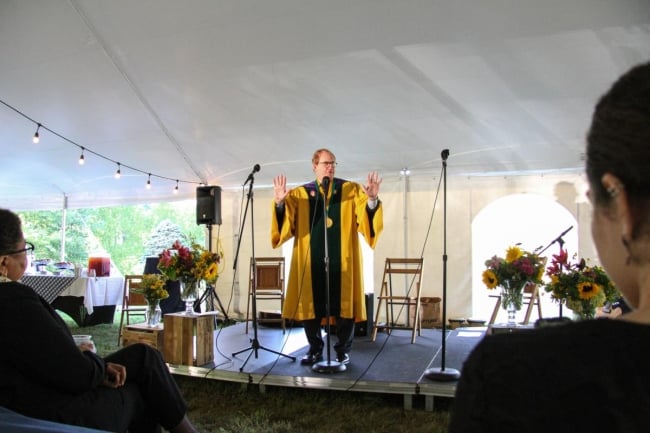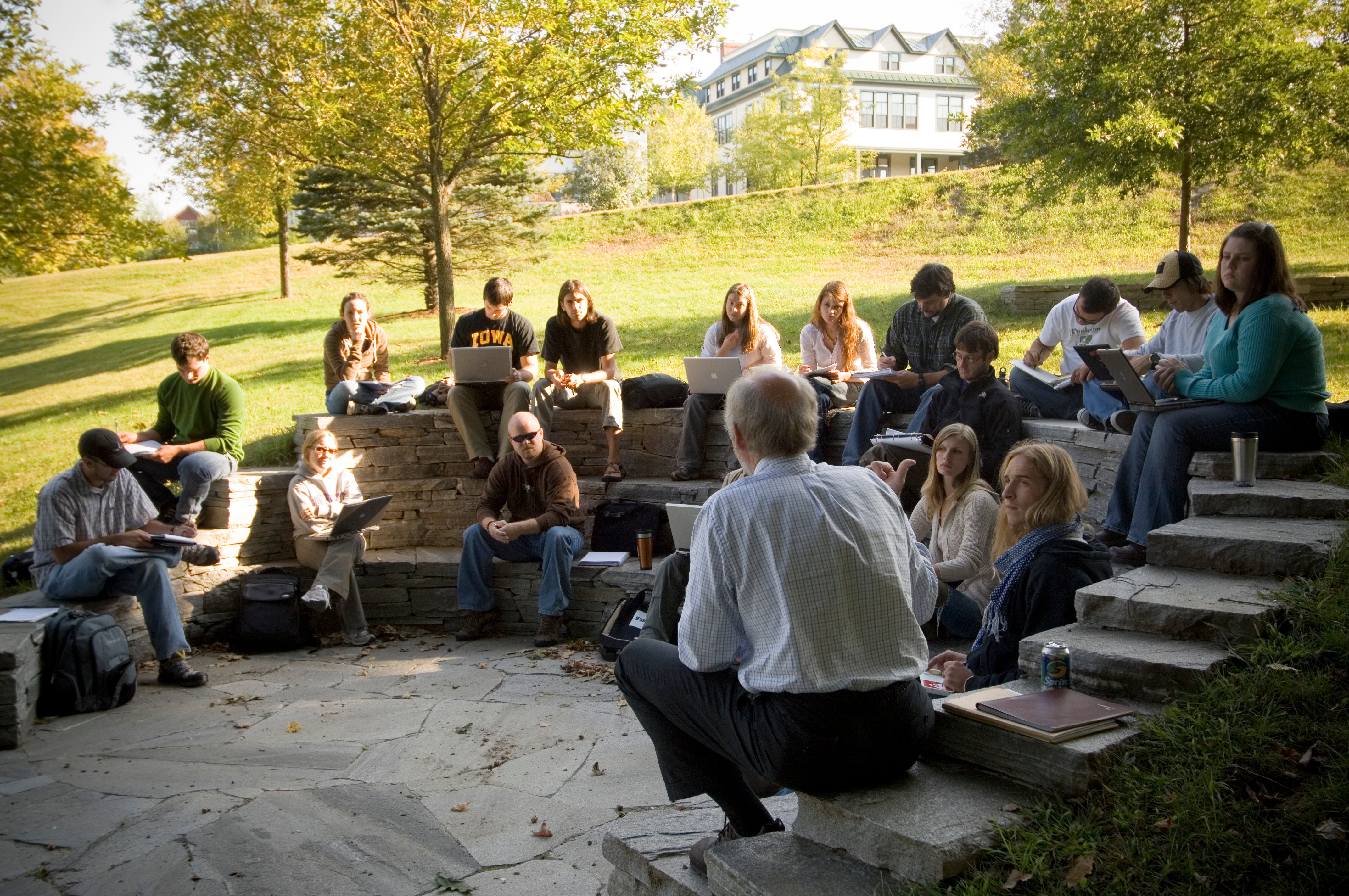You have /5 articles left.
Sign up for a free account or log in.

Vermont Law and Graduate School’s new president Rodney Smolla addresses the college’s inaugural matriculating class under its new name.
Courtesy of Vermont Law and Graduate School
South Royalton, Vt., is a quiet, unassuming town with a population of just over 600. Like most colonial-era New England hamlets, it boasts a smattering of historic buildings and landmarks, including a memorial commemorating the birthplace of Joseph Smith, founder of the Church of Jesus Christ of Latter-day Saints.
South Royalton’s main claim to fame, however, is that it is home to the Green Mountain State’s only law school.
Vermont Law School has doled out juris doctor degrees to students from across New England and beyond since 1972. Many came to the sleepy village in central Vermont because of the college’s sharp focus on environmental law and policy, as well as its progressive outlook on justice.
But like many small institutions around the country, in recent years VLS has suffered from declining enrollment, shifting regional demographics and wobbly finances. Now, the only college in Vermont that offers a J.D. is looking to reinvent itself by betting big on a new slate of master’s degree programs.
In June, officials announced a restructuring plan that includes adding three new master’s programs and changing the college’s name to the Vermont Law and Graduate School, a rebranding that officials hope will better encapsulate the growing diversity of its educational offerings.
The overhaul was made possible in part by an anonymous $8 million donation, the largest ever received by the independent college.
The law school offered a handful of master’s degrees, including the standard master of laws (L.L.M.), even before it added the “G” to its acronym. The restructuring, however, adds degree offerings to the graduate school and puts an equal focus on its non-J.D. programs. It also greatly expands students’ options for online classes.
Rodney Smolla, a veteran lawyer and higher education leader, took over as the Vermont Law and Graduate School’s president in July, just weeks after the changes were announced. He said the college’s innovative restructuring plan and progressive history drew him to the job.
“There’s a real richness in trying to attack these issues from both traditional legal perspectives and public policy perspectives,” he said. “You could offer a lot more in terms of educational opportunities if you invested as much or nearly as much on the public policy side as you do on the traditional law side.”
 Enrollment drops are a concern across higher education, but they have hit law schools particularly hard. Interest in J.D. programs took a nosedive after the 2008 recession, and while the numbers have gone up and down since then, law school enrollments today aren’t nearly what they were.
Enrollment drops are a concern across higher education, but they have hit law schools particularly hard. Interest in J.D. programs took a nosedive after the 2008 recession, and while the numbers have gone up and down since then, law school enrollments today aren’t nearly what they were.
Vermont Law School is no different. According to data from the nonprofit Law School Transparency, VLS welcomed a matriculating class of 212 first-year law students in 2010, but by 2013 that number had fallen to 129.
The drop led to financial difficulties, which were exacerbated by VLS’s independent status, meaning it was not backed by a larger university or system that might help cover costs. In 2018, the college cut tenure for many professors as part of a larger restructuring effort to address budget shortfalls.
Smolla believes that trajectory is changing. Last year’s class of incoming J.D. candidates numbered 174, the college’s highest since the recession. This year, there are 150 new residential J.D. students; a new online J.D. program already filled its 20-seat allotment and now has a waiting list.
“I think we’ve turned the corner,” Smolla said. “I’m very optimistic.”
Small-College Blues in the Green Mountain State
It’s been a rough decade for Vermont’s small liberal arts colleges. In 2019, three private institutions located within a 100-mile radius of one another closed down: Green Mountain College, the College of St. Joseph and Southern Vermont College. A fourth institution, Marlboro College, became the Marlboro Institute when it merged with Emerson College in Boston that same year.
Karen Gross served as the president of the Bennington-based Southern Vermont College from 2006 to 2014. She said that in order to survive, small colleges have to be ambitious in both recruitment strategies and educational offerings.
“VLGS should be commended for trying to innovate, and I think what they did and silo-busting, moving more programs online, and staying close to their mission is smart,” she said. “But I wonder if this is too little, too late.”
Gross, who is also a former senior policy adviser to the U.S. Department of Education, said that small law schools as well as Vermont colleges are under increasing pressure to stand out in a crowded market with a shrinking customer base. She believes her own college could have been saved if not for a “failure to be creative and bold” on the part of the leadership that succeeded her, and she’s concerned that VLGS may suffer from a similar deficiency.
“What they did was move the needle 15 degrees. You need to move the needle 160 degrees,” Gross said. “Now is not the time to tweak at the margins. You want to do something different? Go big.”
Smolla said he’s confident in VLGS’s strategic plan, adding that the college has a few advantages that other small institutions do not. Its progressive mission and status as Vermont’s sole law school have made it a cause célèbre of many state policy makers and philanthropists.
“People care about it, the government cares about it, our senators care. Because it’s so important to the state,” he said. “That’s an advantage that we have that you wouldn’t necessarily see in a small liberal arts college in the middle of the Midwest with many other competing schools.”
Smolla also noted VLGS’s unique focus on environmental issues, something that he hopes will draw students to campus as well as to its online programs, which he says share the same ethos.
“That was always the romance of this beautiful, rural, mountainous state: the idea that people that care about the environment may also love to be in the environment, in nature,” he said. “But that Vermont mind-set is more than just a physical place; it’s a culture and an attitude … so you could be taking our courses from Los Angeles or from China, but in a sense, you’d still be in Vermont.”
‘Diversifying the Product Line’
According to data from the American Bar Association, one in six law students was enrolled in a non-J.D. program during the 2020–21 school year. At some law schools, like the University of Arizona’s James E. Rogers College of Law, students in non-J.D. programs far outnumber traditional law students.
“If you look at it from a purely economic standpoint, this is just diversifying the product line,” said Brian Tamanaha, a law professor at Washington University in St. Louis. “If you see that your potential consumers might be drying up or are insufficient to support your operation, then it makes sense to explore what other products you can offer.”
Such law-adjacent master’s programs offer legal education background on specific issues that might be helpful to those pursuing a career in policy, consulting, accounting, nonprofit advocacy work or a number of other fields where legal knowledge is helpful but a J.D. isn’t necessary.
Many law schools offer master’s programs in tax and entertainment law, for instance; VLGS’s expanded degree offerings build upon its carefully cultivated niche. The new master’s offerings—environmental policy, energy regulation, food and agriculture policy, and restorative justice—all hew close to its long-standing mission of training students to use the law to fight for environmental justice and protection.
Smolla believes that as the climate crisis worsens and issues of environmental injustice become more widespread, VLGS’s degree offerings will be more useful—and in more demand—than ever before.
“There will be a lot of students who are not interested in becoming practicing lawyers or going to law school for three years but who care about these intersections in a spectrum of ways,” Smolla said. “Our feeling was we could attract a lot of students that we don’t currently have.”
Tamanaha, the author of Failing Law Schools (University of Chicago Press, 2012), is, by his own admission, a cynical observer of the legal education landscape. Still, he said that while there are reasons to be skeptical of the value of non-J.D. law school programs, expanding degree options is both a savvy business move and a way to address student demand.
“For many schools, that may ultimately become the primary revenue stream,” Tamanaha said. “If they keep adding master’s programs and continue to see the pool of J.D.s going down, maybe that’s going to be the thing that keeps the operation running.”





